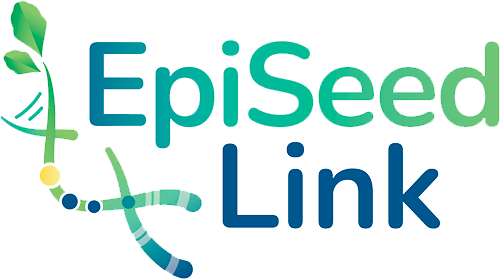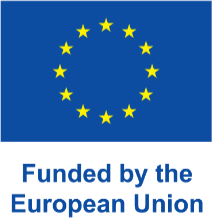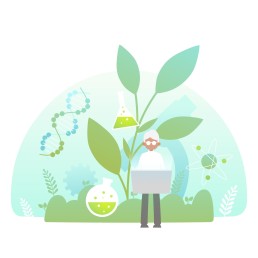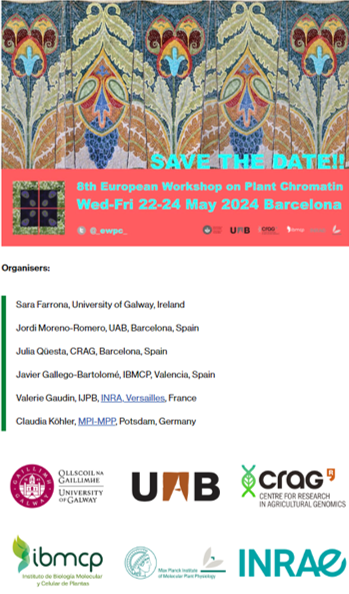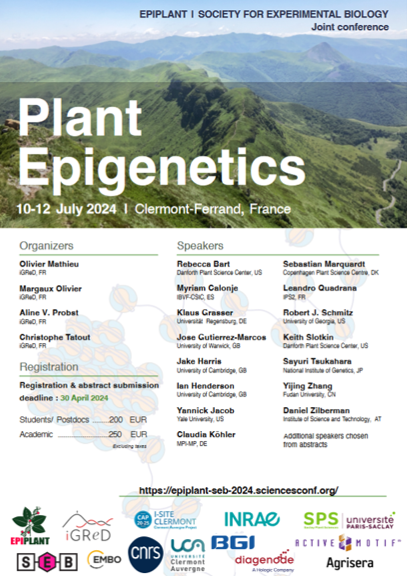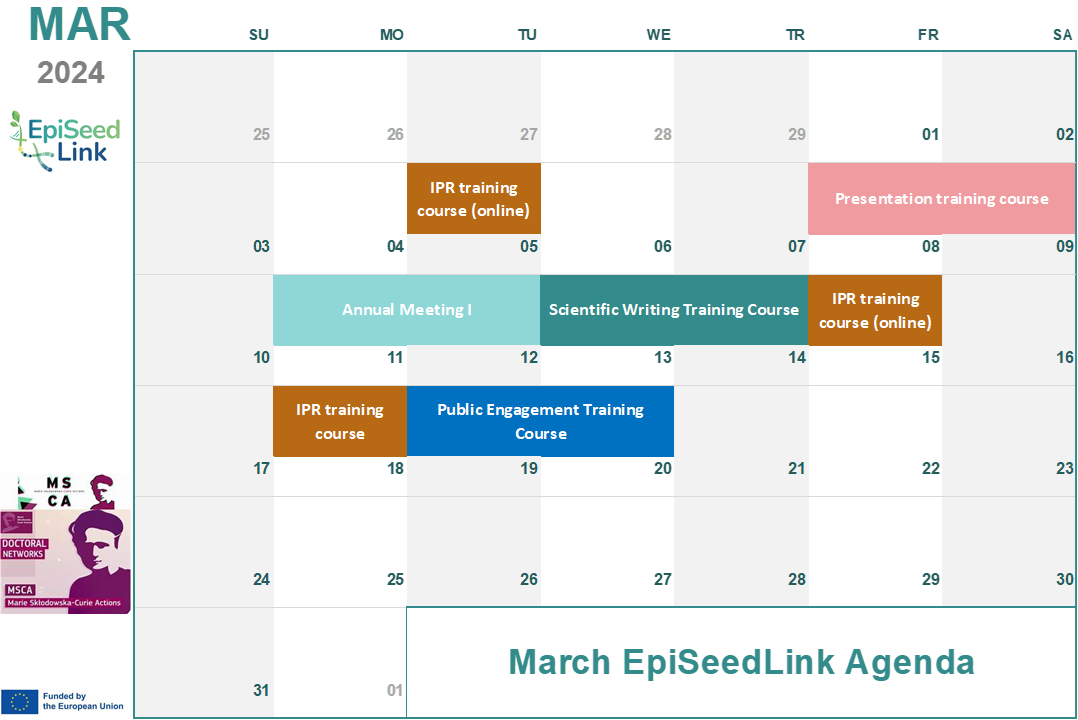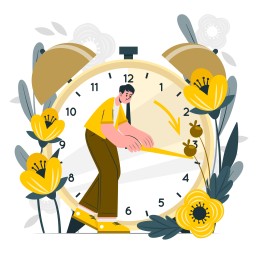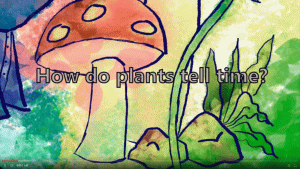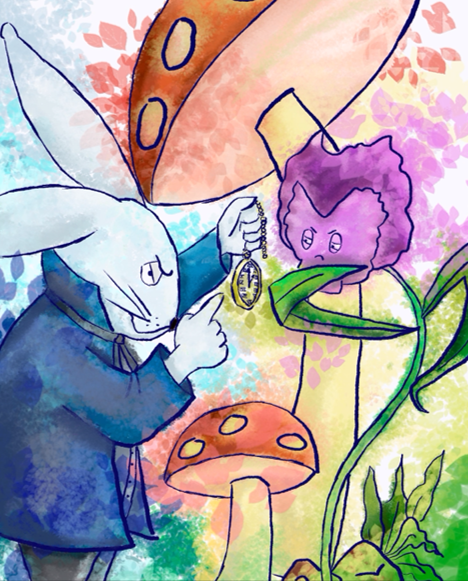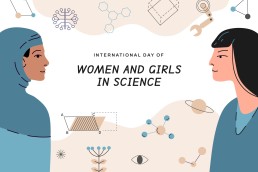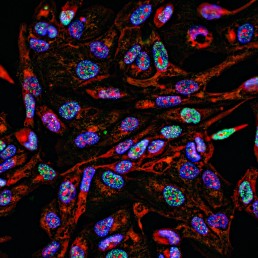Did you know that there are various methods to create transgenic plants?
To insert exogenous DNA into plant cells, there is not only Agrobacterium tumefaciens-mediated transformation (indirect method), as we show you in the last post, but also chemical-physical methods (direct methods):
✅Microinjection
✅Electroporation
✅Permeabilisation of protoplasts
✅ Gene gun
✅Agrobacterium tumefaciens

Text by Martina Curci, PhD students EpiSeedLink Marie Skłodowska-Curie Actions
Frontal image by <a href=”https://www.freepik.es/vector-gratis/concepto-biotecnologia-plana-cientificos_13176506.htm#fromView=search&page=3&position=50&uuid=d8147a2c-f51e-479a-be7a-6e9a18e9b0a2″>Imagen de freepik</a>
Studying genes and transformation plants
When we want to study the role of a gene, we can alter its expression; for example: silencing or suppressing the gene or improving its expression using a strong and constitutively expressed promoter.
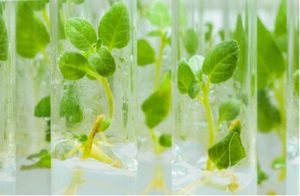
Genetic engineering is a powerful research tool, and it also has the potential to improve the agronomic performance of crops, for these reasons, it has been largely studied and a lot of different techniques have been developed in recent years.
So how do we transform plants?
Transformation is a complex process, it may be transient or stable, depending on the biological question and purpose.
Generally, transformation involves:
- the preparation of explants,
- delivery of genes of interest into plant cells mainly via:
- Agrobacterium or
- biolistic-mediated methods,
- the selection and regeneration of transgenic or gene-edited plants.
Text by Stefania Paltrinieri, PhD Student EpiSeedLink Marie Skłodowska-Curie Actions
Frontal image by <a href="https://www.freepik.es/vector-gratis/concepto-biotecnologia-gradiente-investigador_13176503.htm#fromView=search&page=1&position=8&uuid=dd08f069-784b-4102-a785-4cd12126319a">Imagen de freepik</a>
8th of March, International Women`s Day
EpiSeedLink´s members wish you a happy International Women´s Day
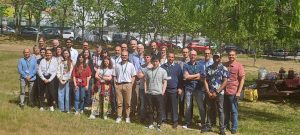
Frontal Image by <a href="https://www.freepik.es/vector-gratis/plantilla-publicacion-redes-sociales-dia-internacional-mujer-degradado_22113362.htm#fromView=search&page=1&position=43&uuid=e7b51a4f-85b7-4eb4-a901-c896f22848a9">Imagen de freepik</a>
Interesting Workshop organized by our Supervisors¡
Some of our Supervisors are organizing two interesting Workshops:
1.- The European Workshop on Plant Chromatin 2024.
Dr. Sara Farrona from the University of Galway (Ireland) and Dr. Javier Gallego-Bartolomé from the Instituto de Biologia Molecular y Celular de Plantas_IBMCP (Valencia, Spain) are involved in the organization of this Workshop with plenty of opportunities to show your work. It will be held at Casa de Convalescència, a beautiful 19th-century building part of the Sant Pau Hospital Art Nouveau complex, in Barcelona on May 22th-24th.
Only a few days left to apply! Submit your abstract for #EWPC2024.
Deadline: 8th March. Join us in Barcelona for three days of exciting discussions about epigenetics and chromatin regulation in plants
All the information on European Workshop on Plant Chromatin 2024 – EWPC2024 (uab.cat)
2.- EPIPLANT/ Society for Experimental Biology. Joint Conference
Dr. ALine Probst from the University of Clermont_Auvergne (Clermont Ferrand, France) is organizing with her colleagues a conference which will be held in Clermont Ferrand on July, 12th-14th. You will be able to share your work and discuss it with experts in the matter.
EPIPLANT/SEB 2024 is a joint meeting of the CNRS Groupement de Recherche (GDR) EPIPLANT and the Society For Experimental Biology.
Deadline: 30th April. Join us in Clermont-Ferrand for other three days of exciting discussions about plant epigenetics, chromatin dynamics, environmental responses and transgenerational inheritance
All the information on EpiPlant/SEB2024
Frontal image by <a href="https://www.freepik.es/vector-gratis/vector-coleccion-gente-negocios_2803290.htm#&position=33&from_view=search&track=ais&uuid=67c1b129-eb1c-4e8c-a960-63bd755f049c">Imagen de rawpixel.com</a> en Freepik
March EpiSeedLink Agenda
EpiSeedLInk´s team will be in Paris in March 2024. We will celebrate our I Annual Meeting, and also around this meeting the fellows will continue learning, performing several training courses.
All these activities will be held at the Hotel La Villa Modigliani in Paris from the 8th until the 20th of March.
TRAINING COURSES
- Intellectual Property Rights (IPR)
Fellows will be trained in data protection (informed consent, data storage, Data Management Plan), intellectual property (IP); protection modalities, IPR management plans, exploitation of results), consortium agreements, confidentiality, publications, responsibility, and jurisdiction, and will be introduced to the value of IP, and how to develop IP strategies with an emphasis on plant breeders’ rights and plant varieties. The training is a mix of theoretical classes, which will be online, and practical exercises, which will be face-to-face in Paris. The trainers are Amaya Mallea, José Luis Erdozain, and Isabel Marco from PONS.
- Presentation training course
This is an intensive, hands-on training course on how to give an Audience-focused Presentation in English to colleagues in the field. Afterwards, the Fellows can deliver their research clearly, in a confident and compelling manner. The trainers are Märiel Vaartjes and Karin Herrenbout from Moile Moile.
- Scientific Writing.
Through discussions, exercises, homework, and detailed feedback, the Fellows will learn the principles of scientific writing and how to write an audience-targeted text. The Fellows will be equipped with writing tools as well as a road map to help them write their next scientific article efficiently. The trainer is Dr Brian Cusack from Scientific Craft.
- Public engagement (PE).
To create awareness among the general public of the value of scientific research, Cell EXPLORERS (CE, www.cellexplorers.com; UoG) will train Fellows in PE. The training includes previous online theoretical and hands-on sessions on general aspects and different formats of PE in science including online practical sessions with children. But now, in Paris, the Fellows will be trained to create educational material for children’s activities delivered to schools/groups. Specifically, Fellows will together prepare materials (e.g. background information, instructions, practical materials) to create a Seed Germination Kit to engage young people in plant science.
Frontal Image by <a href="https://www.freepik.es/psd-gratis/plano-agenda-negocios_2573813.htm#fromView=search&page=4&position=23&uuid=d5e63b44-d8fd-4e19-8c93-c5f53e0a6f84">Imagen de rawpixel.com en Freepik</a>
How do plants tell time?
Continuing thinking about plant curiosities, another question is: How do plants tell time?
Some flowers open their petals at specific times of the day. Some plants move their leaves up during the day, and move their leaves down during the night. These and other plants' events happen at specific times of the day and follow the internal clock of the plants.
The internal clock of plants is called the circadian clock. This is a molecular mechanism independent of environmental cues. Then, even if the plant is in constant light or darkness, the plant will still move its leaves up during the period of the day, and down during the period of the night, for example.
The main function of the circadian clock in plants is to anticipate the day and night and the cycles of temperature during one day. So everything happens at the right time. When the plants anticipate wrong… well, they may have a decrease in productivity, survival, and fitness.
The main references are:
https://www.ncbi.nlm.nih.gov/pmc/articles/PMC6466001/
https://plantsinmotion.bio.indiana.edu/plantmotion/movements/leafmovements/bean/beansleep.html
Text and video by Maira Marins Dourado, PhD Student EpiSeedLink Marie Skłodowska-Curie Actions
Frontal image by <a href="https://www.freepik.es/vector-gratis/ilustracion-concepto-resorte-adelante_137950301.htm#fromView=search&page=3&position=26&uuid=dbed3ed9-1c24-4a59-85d1-919eeef55494">Imagen de storyset en Freepik</a>
February EpiSeedLink Agenda
EpiSeedLink resumes the training courses in February.
Episeedlink´s fellows will learn about Video development for Public engagement.
Sara Farrona, one of our EpiSeedLink Supervisors, and Niall Flaherty, one expert in the field, both from the University of Galway have been working on preparation for the training.
The training will include the lecture ” The History of Life Project” by John Murray, a guest speaker.
Videos are versatile tools for learning and teaching and are key for public engagement tools.
This course will teach how to create novel Public Engagement material in the form of moving images to trigger fascination about plants and agricultural sciences.
Through theoretical and practical sessions, the Fellows will be trained in storyboard creation and video recording.
Finally, in teams, they will produce 4 public engagement videos that will be shown in our Annual Meeting, and used for public engagement activities.
11th of February, International Day of Women and Girsl in Science
EpiSeedLink wishes you a happy International Day of Women and Girls in Science!
Today, we honor the invaluable contributions of women and girls in the field of science.
From groundbreaking discoveries to innovative research, their dedication and intellect have reshaped our understanding of the world.
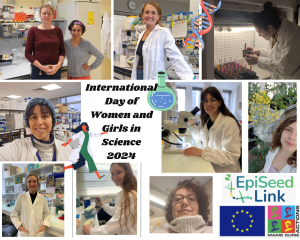
Frontal image by <a href="https://www.freepik.es/vector-gratis/dia-internacional-mujeres-ninas-ciencia_133721452.htm#query=international%20day%20women%20and%20grils%20science&position=
4&from_view=search&track=ais&uuid=f30fda9d-c96d-40b1-bdb8-7b3ecc82a0a8">Freepik</a>
Do the plants sleep?
Thinking about plant curiosities? One question is: Do the plants sleep?
In essence, sleep is defined as a behavior. We sleep when we are in a state where a weak disturbance will not awake us, but a strong disturbance will revert this state rapidly.
However, we can explain sleep in animals in other ways. The period of sleep is to save energy, repair the body, and direct the energy to functions less active when we are awake.
During the evening, plants do very different activities compared to the day.
When it is day, plants focus on absorbing light and producing sugar, for example.
When it is night, plants focus on consuming sugar, producing proteins, and
growing.
3- As different as day and night
Then... do plants sleep? Sleep is mainly described as animal behaviour, that appeared very early in animal evolution.
However, different uses of energy happen to plants during the day and night and when animals are asleep and awake.
So, plants don’t sleep like us. But, like humans, do different activities during the evening compared to the day.
The main references are:
https://www.nature.com/articles/s41583-018-0098-9
https://onlinelibrary.wiley.com/doi/10.1111/j.1365-3040.2007.01708.x
Text and video by Maira Marins Dourado, PhD Student EpiSeedLink Marie Skłodowska-Curie Actions
Frontal image by <a href="https://www.freepik.es/foto-gratis/mujer-descansando-hierba_2042318.htm#page=9&query=plantas%20durmiendo&position=31&from_view=search&track=ais&uuid=eb8662d1-a889-4e00-b157-94e6f57cae34">Freepik</a>
Immunoflorescence technique used in epigenetic research
As researchers, most of us currently perform Western Blots and PCR, but working in the field of epigenetics, we can use other techniques.
Immunofluorescence is an immunohistochemistry technique that uses fluorophores to visualize cellular antigens, such as proteins.
This technique can be utilized to visualize the localization of various cellular components within cells and within cell compartments.
In epigenetics, it's largely used to observe the distribution of different histone modifications or histone variants and so to have an idea of the nuclear organization and chromatin landscape.
For instance, this allows us to see heterochromatic and euchromatic regions within the nucleus and how their distribution changes in different conditions.
The key steps of the protocol are:
-
- Fixation with formaldehyde, to prevent the degradation of your sample
- Incubation with a primary antibody that specifically recognizes the protein of interest or the PTM of interest
- Incubation with a secondary antibody coupled to a fluorophore and, if your protein interacts with DNA don't forget to stain your sample with DAPI!
- Observation with a fluorescence microscope or a confocal microscope
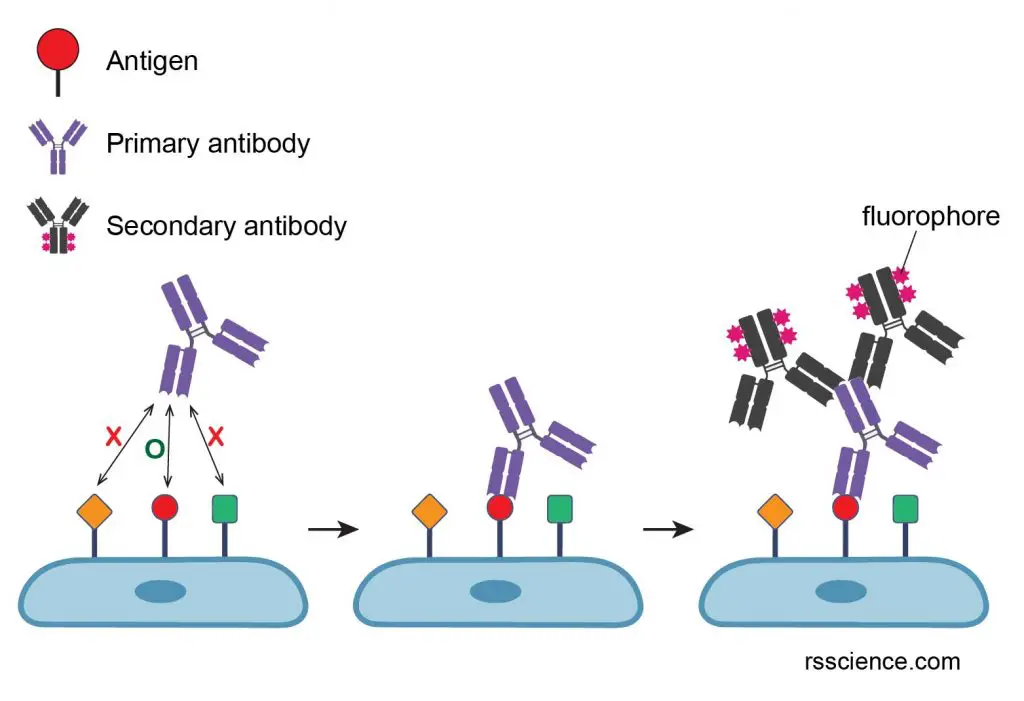
Text by Stefania Paltrinieri, PhD Student EpiSeedLink Marie Skłodowska-Curie Actions
Frontal image by Nicola Ferrari
